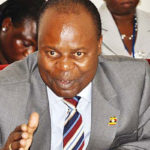Bank of Uganda (BoU) Monetary Policy Committee (MPC) has maintained the December Central Bank Rate (CBR) at 9.5% amid uncertainties in inflation.
Addressing journalists in Kampala on Wednesday, December 6, 2023, Deputy Governor Michael Atingi-Ego said although the outlook for both inflation and economic growth is favourable, the MPC noted that inflation has bottomed out, with significant uncertainties on the horizon.
“Therefore, keeping the CBR unchanged is necessary to anchor inflation around the target in the medium term, while at the same time supporting growth in private sector investment and socio-economic transformation,” he said.
“Consequently, the MPC decided to maintain the CBR at 9.5%, the bands on the CBR at +1-2 percentage points and the margins on the CBR for rediscount and bank rates at 3 and 4 percentage points, respectively. As a result, the rediscount and bank rates will remain at 123% and 13.5%, respectively,” he added.
According to UBOS, headline inflation increased slightly in November 2023, to 2.6% from 2.4% in October 2023, while core inflation remained unchanged at 2.0%.
The Deputy Governor said the medium-term inflation forecast for December 2023 shows that the inflation outlook remains unchanged compared to the October 2023 round of forecasts.
“Inflation is projected to remain below 5% in the near term but return to the target in the medium term. Indeed, core inflation is projected to average 2.5 to 3.5 % in FY2023/24, up from 2 to 3 % in the October 2023 forecast round. The upward revision for FY 2023/24 reflects a higher path for energy prices in the short term,” he added.
Dr Ego also said inflation outlook is subject to elevated risks.
On the upside, he said, the current geopolitical conflicts could escalate and feed into higher international oil prices passing through to domestic pump prices and renewing supply chain disruptions. Furthermore, volatility in global financial markets could increase, triggering an increased outflow of capital and exacerbating the depreciation of the shilling. On the downside, global inflation could decline faster leading to much lower imported inflation. In addition, current rains could result in bumper harvests, pushing down further food crop prices.
However, he said although the domestic monetary conditions remain tight, the current investment activities in the oil and gas sector, higher regional demand for exports on the back of expected higher growth in most of the Sub-Saharan African countries, resilient remittances and tourism Inflows are expected to support economic growth.
“In addition, the low inflationary environment will support a recovery in household real incomes, spurring consumer spending. Indeed, the Composite Index of Economic Activity (CIEA), a high-frequency indicator of economic activity, grew strongly at an annualized rate of 6% in the three months to October 2023,” he added.
Economic growth is projected at 6% in FY 2023/24 and increase to between 6% and 7% in the medium term.
The growth outlook is, however, subject to uncertainties, including slower than expected global and regional growth; a resurgence of supply chain distortions if the geopolitical tensions escalate, tighter fiscal policy in part due to unfavourable global financial markets, which could restrict government development expenditure, tighter credit conditions constraining household consumption and private sector investments.







